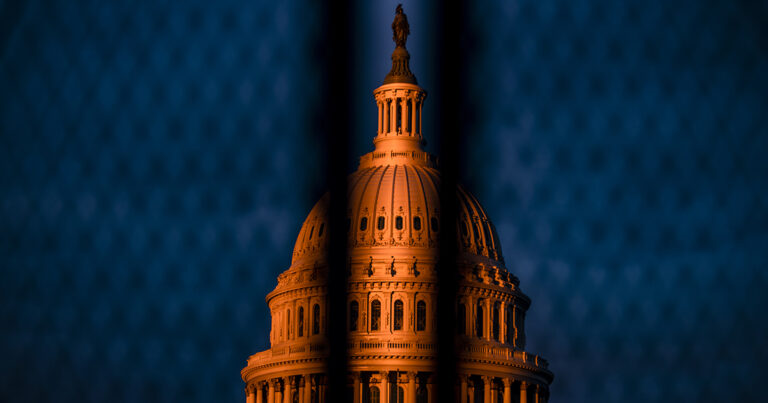In the event of a disaster, the federal government will often provide support to state and local governments in their response and recovery efforts. While that support is provided through various agencies and departments, the Federal Emergency Management Agency (FEMA) plays a predominant role and gives financial assistance to local relief activities through its Disaster Relief Fund (DRF).
As severe storms become more common due to climate change, there will be an increase in the need for federal resources — which are also used to address other forms of emergencies, including earthquakes, chemical spills, mass violence, and pandemics. Here, we provide an overview of how federal disaster assistance works and what role the DRF plays in federal disaster spending.
How Is Disaster Response Structured?
Climate and weather-related natural disasters are becoming increasingly frequent, endangering lives and extracting a significant economic cost. Since 2020, damages from climate and weather disasters have averaged $149 billion per year — a 50 percent increase from the prior decade and four times the cost of the 1990s. The average number of disasters that cause significant damages (those that cost at least $1 billion, adjusted for inflation) has also risen from about six events per year in the 1990s to 23 events per year over the last five years.
When a disaster or emergency occurs, the local government is primarily responsible for overseeing the response and recovery operations. They use their own funds and assets to provide initial emergency response services, but if the situation is beyond the capabilities of the local government the state government may step in to provide additional assistance. When a presidential disaster declaration is issued to a state in need, federal aid provides uninsured losses and expenses. State and local governments are expected to contribute funds to the relief efforts, and the cost-sharing requirements vary by the type of assistance provided.
Upon approval of a major disaster declaration, the federal government can activate dozens of its agencies and departments to provide monetary assistance and deploy federal personnel as well as other resources. FEMA is the main agency responsible for activating, implementing and coordinating federal disaster efforts. Other federal agencies such as the Department of Housing and Urban Development, the Department of Agriculture, the Department of Transportation, the Department of Defense, and the Small Business Administration may also provide assistance under certain circumstances.
The vast majority of federal resources go to preparing for and responding to natural disasters, such as hurricanes and earthquakes, but funds have occasionally been used for other types of emergencies like person-made disasters and biological hazards. For example, the federal government authorized nearly $20 billion through four different agencies in response to the September 11 terrorist attacks. During times of non-emergency, governments invest in a variety of activities including disaster planning and training, evaluation of hazards, and long-term recovery programs.
How Does Federal Government Fund Disaster Response?
The federal government funds disaster response through nearly 20 different agencies and departments. Each agency funds its own disaster-related programs from its appropriated budget amount, which may be supplemented with additional appropriations throughout the year.
FEMA, housed under the Department of Homeland Security, is the primary agency responsible for general disaster assistance and receives the largest amount of money for financing federal disaster relief activities through the DRF. Other agencies and departments coordinate responses to disasters that target specific populations.
The DRF accounted for 44 percent of all federal disaster relief funding in fiscal year (FY) 2025 to provide funding for the aftermath weather and climate-related events. Most of the DRF is used for grants and other direct financial assistance to state and local governments and individuals. The Department of Agriculture and related agencies received the second largest amount, which was predominantly dedicated to producers who had suffered crop and livestock losses due to hurricanes, droughts, wildfires, and floods.
Where Does the Disaster Relief Fund Get Its Funding?
The DRF is funded through the appropriation process as a part of FEMA’s budget. Any unused balance is carried over to the next fiscal year. In the event of a major disaster, Congress is likely to provide supplemental funding if the DRF’s balance and current funding are not sufficient to cover costs in a given year. While annual appropriations help the government to budget for costs in advance, supplemental appropriations enable Congress to address unanticipated needs on an ad hoc basis. From FY 1993 to FY 2023, 68 percent of all appropriations for disaster relief has been provided through supplemental appropriations.
How Has the Disaster Relief Fund’s Spending Changed Over Time?
While the funding for and spending from the DRF can vary each year depending on the frequency and severity of disasters, there has been an increase in DRF funding and outlays, on average, over the last thirty years — particularly after 2005. From 1993 to 2004, DRF spending averaged $3.4 billion a year; spending has since increased to an annual average of almost $17 billion over the 2005 to 2024 period.
That increase in spending has been primarily driven by supplemental appropriations for a handful of severe disasters in the past several years. In particular, the relief efforts for hurricanes Katrina, Rita, and Wilma, all of which hit the United States in 2005, accounted for 16 percent of DRF spending since that year (all hurricanes accounted for 56 percent of DRF outlays). The federal response to the COVID-19 pandemic, which authorized the use of DRF funds for certain types of unemployment compensation in addition to emergency assistance and medical treatment, also accounted for 40 percent of spending. Other severe events, such as wildfires, flooding, tornadoes, and earthquakes, also contributed to higher spending levels. In fact, FEMA has projected that the DRF would run out of funds before the year ends nine times since 2001. When that happens, the DRF enters a state of Immediate Needs Funding, in which it only continues life-saving, life-sustaining, and critical ongoing disaster operations.
FEMA Disaster Spending and the Federal Budget
While the DRF constitutes a small portion of the federal budget, it is the single largest source of disaster spending by the federal government. Year-to-year appropriations have greatly fluctuated over time, given the difficulty of accurately predicting the timing and extent of disasters. However, the cost of disaster assistance has slowly increased and that trend is projected to continue due to changing climate conditions.
As the nation faces increasing numbers of natural disasters and other unpredictable emergencies, lawmakers should consider methods to responsibly prioritize disaster needs in the budget. That way, limited federal resources can be effectively deployed to remedy the damage inflicted following a natural disaster.
Photo by Apu Gomes/Getty Images
Further Reading
How Did the One Big Beautiful Bill Act Affect Federal Spending?
Overall, the OBBBA adds significantly to the nation’s debt, but the act contains net spending cuts that lessen that impact.
How Much Does the Government Spend on International Affairs?
Federal spending for international affairs, which supports American diplomacy and development aid, is a small portion of the U.S. budget.
A Brief History of U.S. Government Shutdowns
Government shutdowns (and the threat of them) are a recent phenomenon and something other developed countries don’t contend with.


